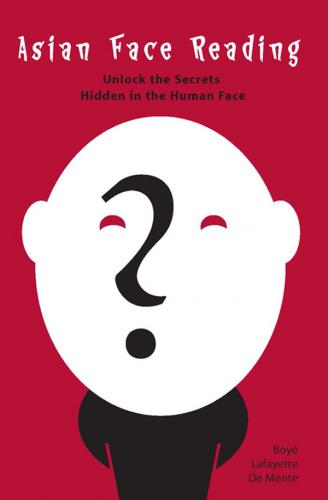First published in 2003 by Journey Editions, an imprint of Periplus Editions (HK) Ltd., with editorial offices at 364 Innovation Drive, North Clarendon, VT 05759 U.S.A.
Copyright © 2003 Boyé Lafayette De Mente All rights reserved. No part of this publication may be reproduced or utilized in any form or by any means, electronic or mechanical, including photocopying, recording, or by any information storage and retrieval system, without prior written permission from the publisher.
Library of Congress Cataloging-in-Publication Data De Mente, Boye.
Asian face reading : unlocking the secrets hidden in the human face / Boye de Mente p. cm.
ISBN 978-1-4629-0308-5 (ebook)
1. Physiognomy–China. 2. Physiognomy–Japan. 3. Facial expression–China. 4. Facial expression–Japan. I. Title
BF851.D37 2003
138–dc21
2003050718
Distributed by
North America, Latin America, and Europe
North America, Latin America, and Europe
Tuttle Publishing
Distribution Center
Airport Industrial Park
364 Innovation Drive
North Clarendon, VT 05759-9436
Tel: (802) 773-8930
Fax: (802) 773-6993
Email: [email protected]
Asia Pacific
Berkeley Books Pte. Ltd.
61 Tai Seng Avenue, #02-12
Singapore 534167
Tel: (65) 6280-3320
Fax: (65) 6280-6290
Email: [email protected]
Japan
Tuttle Publishing
Yaekari Bldg., 3F
5-4-12 Ösaki, Shinagawa-ku
Tokyo 141-0032
Tel: (03) 5437-0171
Fax: (03) 5437-0755
Email: [email protected]
First edition
09 08 07 06 05 04 03 9 8 7 6 5 4 3 2 1
Design by Linda Carey
Printed in the United States of America
Contents
Preface
Face reading, a practice as old as man, is a universal art that we all use every day—with varying degrees of skill. We all know and respond to facial expressions that indicate fear, anger, merriment, and other moods, and we know from experience that facial characteristics, such as unusually large eyes or big noses, have an important influence on our lives.
But there is a great deal more to face reading than these obvious signs. The face reveals facts not only about a person’s mood, but about his or her character, health, personality, sexuality, popularity, ability to make money, social status, and life expectancy as well.
And just as our faces influence our lives, life in turn changes our faces—for better or worse.
The principles of face reading, or nin so mi (pronounced neen so me), on which this book is based were first developed in China ages ago. As the generations passed in ancient China, doctors and scientists, who were members of the educated and privileged class, noted that body build and facial features had a profound influence on people’s lives, from health and longevity to the degree of economic and social success they achieved. These learned men began keeping notes on their observations.
As time passed, a number of these healers and scholars wrote treatises on the relationships they discerned between the shape of the body, the head, and the facial features, and the character, personality, and other attributes of individuals. Eventually, face and body reading became a recognized profession.
The Emperor and other members of the Imperial Court as well as the elite gentry and military leaders patronized face readers in their professional as well as their private lives, further encouraging the study and use of the practice.
As Chinese learning and influence spread throughout East and Southeast Asia, the art of face reading also spread, becoming especially important in Korea and Japan, where the population was especially drawn to the practice, and it soon became an integral part of their cultures. Thereafter, the art of face reading was systematically applied in all areas of their lives, particularly in politics, business, and arranging marriages. As they did with most of the arts and crafts they imported from China, Japanese practitioners of face reading further refined and added to the scope, depth, and use of the art.
In the late 1930s, when Japan was preparing for all-out war, the Japanese air force called in a face-reading expert to study the faces of new recruits and advise on whether they should be trained as pilots, mechanics, truck drivers, and so on.
This development was what led me to take an interest in face reading. In 1954, when I was editor of Preview magazine in Tokyo, I learned that the face reader who had been called in by the Japanese military was still alive and lived just outside the city.
With the help of a Japanese assistant, I managed to get an interview with him and did a story about his prewar experience.
This led to my doing more research on the subject at the National Diet Library, where I found a trove of treatises, old and new, on the subject.
Beginning around 1960, there was something of a face-reading renaissance in Japan, with more than a dozen scholarly works on the subject published over a period of about ten years.
Face readers, along with palm readers and other soothsayers, once again became common on city sidewalks
